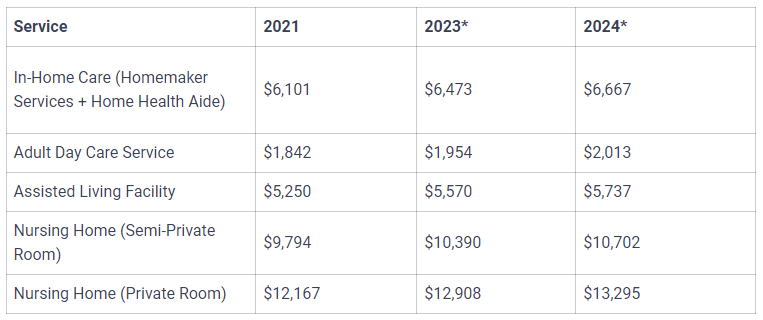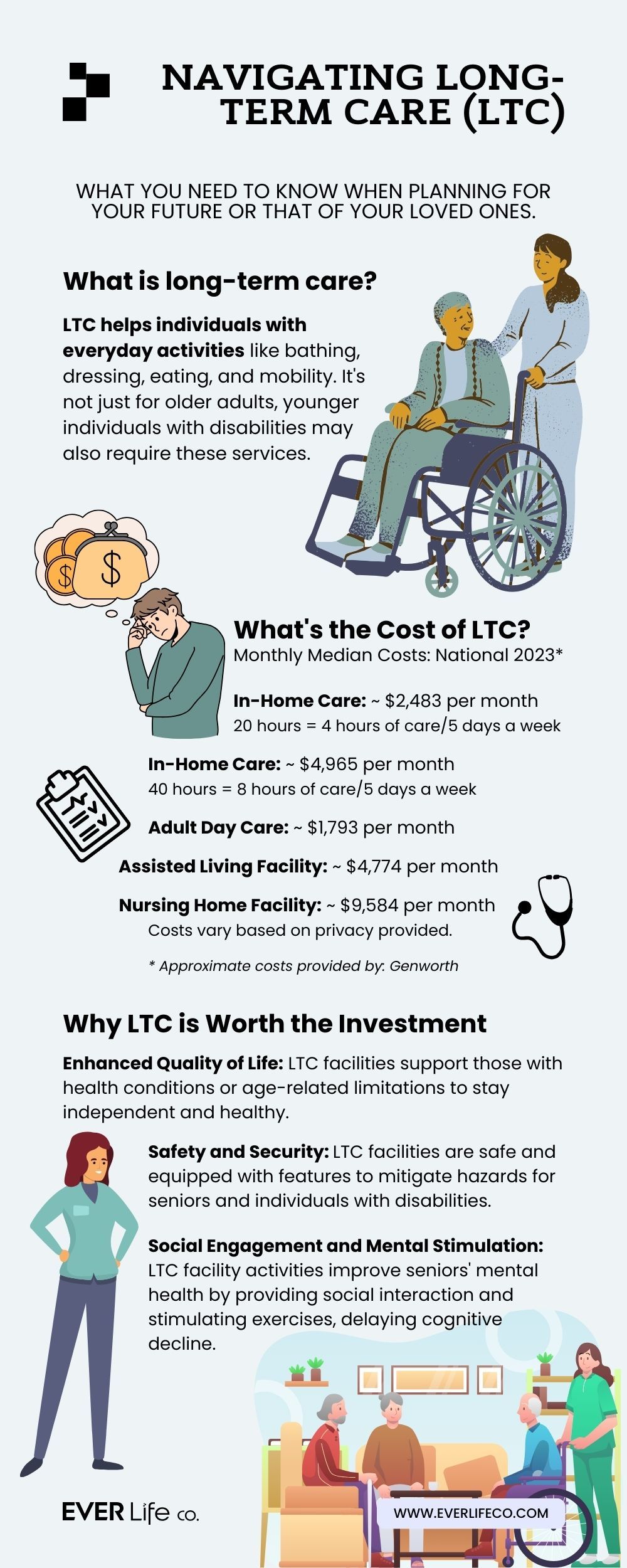The need for extended healthcare and assistance becomes more apparent as we age. Long-term care (LTC) encompasses a range of services designed to support individuals who require help with daily living activities due to aging, chronic illness, or disabilities.
In this blog, we will delve into what long-term aide is, how it works, and the crucial factors to consider when planning for your future or that of your loved ones.
Understanding Long-Term Care (LTC)
What is Long-Term Care?
LTC refers to various medical, social, and personal services to assist individuals with difficulty performing everyday activities alone.
These activities include bathing, dressing, eating, mobility, and more. It’s important to understand that long-term aide is not exclusively for older adults; younger individuals with disabilities or chronic conditions may also require these services.
Types of Long-Term Care Services
LTC encompasses a broad spectrum of services, from home-based to facility-based aide. Home-based supervision enables individuals to receive assistance in the comfort of their homes, while facility-based includes assisted living communities, nursing homes, and memory care units.
- In-Home Care: Provides support with daily tasks, such as personal care, meal preparation, medication management, and housekeeping. Home-based long-term care costs vary depending on the level of assistance required, but it’s generally more affordable than a facility-based service.
- Assisted Living: Offers a balance between independence and assistance, providing help with daily activities while promoting social engagement. Assisted living costs are typically higher than home supervision but may include room and board, meals, and social activities.
- Nursing Homes: Ideal for individuals with complex medical needs who require round-the-clock medical attention and skilled nursing aide. Nursing home care is the most expensive option due to the level of health care aide and supervision provided.
- Memory Care Units: Specialized aide for individuals with Alzheimer’s disease or other forms of dementia, focusing on cognitive support and safety.
Who Needs LTC?
Demographics of LTC Recipients
Long-term care needs are prevalent among older adults, especially those 65 and above. As life expectancy increases, so does the likelihood of requiring long-term care services. However, it’s essential to remember that accidents, illnesses, or disabilities can necessitate these services at any age.
Common Reasons for Needing LTC
- Aging-related conditions, such as arthritis, osteoporosis, and age-related macular degeneration.
- Chronic illnesses, including diabetes, heart disease, and respiratory disorders.
- Cognitive impairments, such as Alzheimer’s and dementia
- Disabilities resulting from accidents or injuries.
How Long-Term Aide Works
Sources of Payment for Long-Term Care Assistance
While LTC can be essential for maintaining an individual’s quality of life, it can also be expensive. Understanding the various sources of payment for LTC is crucial for effective planning.
1. Private Pay and Out-of-Pocket Expenses
Private pay refers to using personal funds to cover long-term care expenses. It’s a viable option for those with sufficient savings or assets. However, relying solely on private pay can quickly deplete one’s savings, leading to financial strain.
2. Long-Term Care Insurance
Long-term care insurance is specifically designed to help cover the costs of long-term care services. It provides financial protection and flexibility in choosing the type and location of aide services.
The premiums for long-term care insurance depend on factors such as age, health status, and the coverage amount.
3. Government Programs
Medicare: Medicare is a federal health insurance program primarily for people 65 and older. While it covers some short-term skilled nursing and home health services, it does not typically cover long-term care services.
Medicaid: Medicaid is a joint federal and state program that provides medical assistance to low-income individuals. It does cover long-term care services, but eligibility criteria and coverage vary by state.
Veterans Affairs Benefits: Veterans and their spouses may be eligible for various long-term care benefits through the U.S. Department of Veterans Affairs (VA). These benefits include financial assistance for home-based supervision, assisted living, or nursing home care.
The Average Costs of Long-Term Care Services
In 2021, Genworth conducted a survey that revealed the United States witnessed a median annual cost of $61,776 for in-home care provided by a Home Health Aide and $59,488 for Homemaker services.
LTC costs significantly differ based on the geographic location. Urban areas often have higher costs than rural areas, making it essential to consider potential relocation when planning for long-term care needs.
Let’s take a look at the numbers for the state of California.
Monthly Median Costs: California - State (2021 vs. 2023 & 2024)

Expect the continued rise of prices as the American population rapidly ages and the increased demand for services.
Projected data indicates that government and household annual home health costs are set to experience a notable upswing, surpassing an average increase of 7% by 2030. Furthermore, per-person prices are expected to surge even higher, exceeding a staggering 9% rise during the same period. [Source]
These substantial estimates emphasize the urgency of addressing the rising expenses associated with home health aide and the importance of proactive planning for the future.
Factors to Consider for Long-Term Care Planning
Planning for LTC involves carefully considering various factors to ensure that you or your loved ones receive the most appropriate and affordable aide when needed.
Assessing Your Long-Term Aide Needs
1. Evaluating Health and Independence
Before making long-term aide decisions, assessing your current health status and level of independence is essential. Consider factors such as medical conditions, mobility, and any existing support systems.
Speak with your doctor about how your family history and lifestyle may impact your LTC needs.
2. Family Support and Availability
Discuss LTC plans with family members and identify who can provide support and assistance. Understanding the availability and willingness of family members to help can influence the type of long-term aide you choose.
Financial Planning for Long-Term Aide
1. The Importance of Starting Early
Long-term care planning should ideally start well before the need arises. The earlier you begin, the more time you have to save and explore various financial options.
2. Calculating Long-Term Care Costs and Funding Options
Estimate the potential costs of long-term care based on your preferences and location. Factor in projected inflation rates and explore funding options, such as long-term care insurance or setting up a dedicated savings fund.
Long-Term Care Insurance
1. Understanding Policy Coverage and Exclusions
When considering long-term care insurance, thoroughly review the policy coverage, limitations, and exclusions. Ensure that it aligns with your anticipated needs and preferences for aide services.
2. When to Purchase Long-Term Care Insurance
Purchasing long-term care insurance at a younger age can result in lower premiums. However, balancing affordability and securing sufficient coverage for potential long-term care needs is essential.
You can purchase an LTC Rider for added protection with a standard life insurance policy. Adding a rider is cheaper than stand-alone long-term care insurance. Some riders offer inflation protection.
Speak with your insurance company about your options and devise a strategy that best suits you or your loved ones.
Government Assistance Programs
1. Eligibility Criteria for Medicare and Medicaid
Understand the eligibility requirements for Medicare and Medicaid to determine if you or your loved one qualifies for these government assistance programs. Research the specific long-term care services covered by each program.
2. Leveraging Veterans Affairs Benefits for Long-Term Care
If you or your spouse is a veteran, explore the various benefits provided by the U.S. Department of Veterans Affairs. These benefits can significantly alleviate the financial burden of long-term care.

Long-Term Care Planning Strategies
Planning for long-term care involves more than only financial considerations. It requires thoughtful decision-making and exploring assistance options that align with personal preferences and goals.
Creating a Comprehensive Long-Term Care Plan
1. Identifying Personal Preferences and Goals
Discuss and document personal preferences for long-term care. Consider factors such as staying at home for as long as possible, proximity to family and friends, and the importance of social engagement.
2. Involving Family and Loved Ones in the Decision-making Process
Long-term care planning is a family affair. Involve your loved ones in discussions about your preferences and goals to ensure everyone is on the same page.
Exploring Alternatives to Institutional Services
1. Home Aide and Community-Based Services
Explore the option of receiving an aide in your own home through home services. Community-based services can also provide social support and assistance while allowing individuals to remain in familiar surroundings.
In-home services are the most popular option for many Americans.
2. Assisted Living Options and Benefits
Assisted living communities offer a balance between independence and support. Research facilities in your area, considering amenities, quality of assistance, and affordability.
Legal and Estate Planning Considerations
1. Power of Attorney and Advance Directives
Designate a trusted individual to act as your power of attorney for healthcare and financial decisions if you cannot make them yourself. Additionally, consider creating advance directives outlining your medical treatment preferences.
Leaving this information will limit disagreement among family members about how to proceed with your LTC. Your POA is part of your end-of-life planning. Read this blog for more information on the topic.
2. Protecting Assets and Minimizing Tax Implications
Consult with a financial advisor or attorney to explore ways to protect your assets and minimize potential tax implications related to long-term care expenses.
Overcoming Challenges and Misconceptions
While long-term care planning is crucial for a secure future, there are common challenges and misconceptions that individuals and families may encounter. Understanding and addressing these obstacles can help make the planning process smoother.
Addressing Emotional and Psychological Barriers
1. Accepting the Need for LTC
Acknowledging the possibility of needing LTC can be emotionally challenging. It’s not easy to picture life without independent living.
Research findings indicate that approximately one-third of individuals aged 65 years today may not require long-term care support throughout their lives. However, a substantial 20 percent of this population will necessitate assistance for a duration surpassing five years. Women typically need longer LTC (3.7 years) than men (2.2 years). [Source]
These statistics underscore the importance of long-term care planning and financial preparedness to address potential LTC needs in later stages of life. So, despite the uncomfortable nature of the topic, it’s essential to have open conversations and provide support to loved ones during this process.
Family involvement can lessen the anxieties and prepare everyone involved for what might become the inevitable.
2. Coping with the Fear of Losing Independence
Many individuals fear losing their independence when considering long-term aide. Long-term care services are designed to enhance the quality of life and liberty, not diminish it.
Breaking Myths About Long-Term Care Planning
1. “I’m Too Young to Plan for LTC”
Long-term care planning isn’t only for older adults. Age is only one cause of many that may lead to LTC. Accidents, illnesses, and disabilities can occur at any age, making planning necessary for everyone.
2. “Medicare Will Cover All My Long-Term Care Costs”
Contrary to popular belief, Medicare only covers a limited portion of short-term skilled nursing aide and does not pay for custodial services or LTC in most cases. This gap in your coverage can cause a financial burden on family members, which is why seeking comprehensive protection is so critical.
Common Mistakes to Avoid in Long-Term Aide Preparation
1. Procrastinating on Planning
Procrastinating on long-term care planning poses grave risks, leaving you vulnerable to unforeseen challenges and financial strain when the need for aide arises.
Failing to act promptly may limit available options, leading to inadequate arrangements and increased stress for you and your families. Take proactive measures now to secure a stable future.
2. Not Reviewing and Updating Plans Regularly
Life circumstances can change. Neglecting to review LTC plans as they do can lead to outdated and ineffective strategies. Shifts in health, financial situations, or family dynamics may render initial plans inadequate.
Without updates, you risk facing inappropriate aide solutions, financial instability, and uncertainty during critical times. Regular reviews ensure plans remain relevant and reliable, providing peace of mind for the future.
Support and Resources for Long-Term Care Planning
Navigating the complexities of long-term care planning can be overwhelming, but you don’t have to do it alone. Valuable support systems and resources are available to assist you in making informed decisions.
Seeking Professional Advice and Guidance
1. Consulting with Financial Advisors and Elder Law Attorneys
Financial advisors experienced in long-term care planning will help you create a tailored financial strategy that aligns with your goals and resources. Additionally, an attorney specializing in legal matters related to older adults can provide valuable advice on estate planning and asset protection.
2. Understanding Geriatric Care Management Services
Geriatric care managers are professionals who specialize in coordinating and managing the supervision of older adults. They can assess needs, develop plans, and provide guidance on LTC options.
Community and Non-Profit Organizations
1. Local Resources for LTC Information and Assistance
Many communities have organizations and agencies dedicated to providing information and assistance regarding long-term care services. These resources can help you navigate the available options in your area.
2. Support Groups and Educational Programs
Joining support groups for individuals and families facing LTC challenges can offer emotional support and practical advice. Additionally, attending educational programs can increase your knowledge about long-term care planning and related topics.
Conclusion
Long-term care planning is critical to securing a stable and dignified future for you and your loved ones. Understanding the scope and types of LTC services, exploring the potential benefits of various funding options such as insurance and government programs, and starting the planning process early are vital steps.
Seeking guidance from financial advisors, elder law attorneys, and geriatric care managers is essential for crafting comprehensive plans. A proactive and thoughtful long-term care plan will empower you and your loved ones to navigate this journey with confidence and peace of mind.






